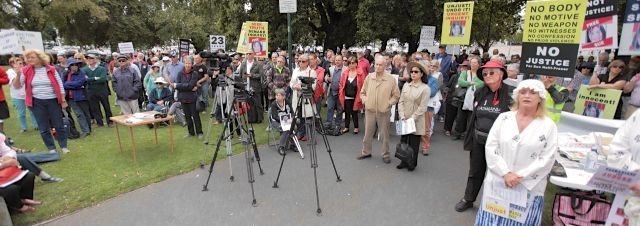
Under a new legal test, Sue Neill-Fraser may well be free…instead of jailed in Risdon Prison. The mysterious ways of DNA in her trial continue to puzzle observers.
DNA dances to different tunes
By Bill Rowlings, CEO of Civil Liberties Australia
In another surprising development in the Yacht No Body case, the Tasmanian Court of Criminal Appeal (CCA) in December 2013 changed a key test for ordering a mistrial.
The court will now order a retrial if there is a “reasonable” possibility that a prosecutor’s mistake influenced a jury’s decision, the case of Smart v Tasmania decided (reference below).
Previously, a “significant” possibility was the minimum bar an appeal had to jump.
Sue Neill-Fraser should be granted a new trial because now – under the new test – her conviction for murdering her disappeared husband is unsafe.
Several CCA findings in her 2012 appeal, where she was refused a retrial, depended on the “significance” of what was at issue.
In general, where it suited the status quo (her conviction) for a prosecutor’s or judge’s words or action/inaction to be interpreted against Neill-Fraser, that was achieved by the three CCA judges finding the matter was “significant” or “insignificant”.
Where something could have been determined in her favour, “significance” and “insignificance” were ruled in reverse by the three judges, Crawford, Tennent and Porter.
For example, in her original trial the now-suspended* Director of Public Prosecutions, Tim Ellis, made a mistake by claiming in front of the jury that her DNA was on a latex glove found in the saloon of the yacht from which her partner, Bob Chappell, disappeared.
Although DPP Ellis admitted his error in the appeal court, the three appeal judges thought such a false claim to the original trial jury was “insignificant” in the overall case, and refused to order a retrial. Very many people would think there was a “reasonable” possibility that the claim might have influenced the jury.
I know of no other trial and appeal in Australia where the presence or absence of DNA has been treated in such a puzzlingly inconsistent fashion as in this case:
- It was obviously thought significant enough for the DPP to claim (in error) that Neill-Fraser’s DNA was on a latex glove discovered on a stove, and to claim that fact proved she had cleaned up a what he claimed was bloody scene in the yacht’s saloon where she had murdered her husband…
but
- When the DPP found out he had made a mistake about whose DNA was on the glove, it seems that self-same latex glove, guilty as hell in one scenario as being an accessory to an alleged murder, had been absolved of any criminal intent…simply because it wasn’t Neill-Fraser’s DNA!
What an amazingly dexterous latex glove: sinister one moment, innocent the next!
Benign v malignant DNA
In another mysterious twist, the DNA of a young female who claimed she had never been on the yacht was found on board. The police inspector leading the investigation explained the finding away as not important. The police failed to diligently follow leads as to how that person may have been involved with others in boarding the yacht, and whether that person had any boating skills or background. This person’s DNA was apparently considered “benign” DNA by the police.
When Ms Neill-Fraser touched a winch handle and ropes – after police had concluded about six hours of detective and forensic examinations and only then was she permitted to board her own yacht – it was claimed she touched the items to smear her DNA on them. But her DNA would have been on every surface without the need to touch anything: she had been on the yacht using winches and ropes virtually every day for the preceding eight weeks, including sailing it full-time for two weeks from Brisbane to Hobart during that period.
However, her alleged touching of the winch handle and ropes was done deliberately to smear her “malignant” DNA on board, police told the jury, claiming she was therefore acting deviously.
The police lack of logic, apparently accepted by the jury, is unfathomable…as is how the winch handle and rope touching by Ms Neill-Fraser was one of the circumstances that led to her conviction. There is a “reasonable” possibility that the evidence should not have been admitted because of its illogicality.
From the outset of the myopic police investigation, If an interpretation could be made against Ms Neill-Fraser, it was. Where it was possible to interpret a nuance in her favour, it was ignored, glossed over, or gone around.
Many Tasmanians believe there should be a public inquiry by an interstate judge into the handling of the police investigation, and the trial and appeal hearing, in the Yacht No Body case.
The entire unsatisfactory saga needs fresh air blown through it, and transparency visited upon it.
The Giddings government may be headed for defeat on 15 March. It should do the right thing and initiate an inquiry into the case. Most of the jurisprudence fiasco occurred on Lara Giddings’ watch: she was Attorney-General and Minister for Justice for most of it, then Premier for the CCA findings.
Tasmanian justice deserves an inquiry, for the good of the state equally as much as for Ms Neill-Fraser.

Background: Five-year anniversary, Australia Day 2014
Sue Neill-Fraser is serving 23 years in Risdon Prison for allegedly killing her husband Bob Chappell on Australia Day 2009 on the yacht they owned, Four Winds, moored at Sandy Bay. She continues to vehemently deny the charge. Civil Liberties Australia believes she is innocent.
Bob Chappell disappeared overnight on the evening of Australia Day.
There was – and is to this day – no body. There was no clear proof of murder: drowning was a possibility the judge ruled, and drownings can be accidental. There was no eyewitness. There was no weapon…except one invented by the prosecutor in an imaginary scenario presented to the court. There was no proven “death” blood found, just a few drops, seemingly not enough to back the claim that Chappell was hit on the head with the DPP’s imagined wrench, more than once.
The police investigation was so tunneled it might have provided a new way of crossing the Derwent.
In the recent December 2013 case, Smart v Tasmania, the Court of Criminal Appeal decided that Smart should be acquitted because there was a “reasonable” possibility that a prosecutor’s false claim in court could have influenced the jury’s decision to convict. His 21-year murder conviction was overturned (though he is likely to face trial on another serious charge).
Almost certainly Neill-Fraser’s appeal would be decided differently today under the “reasonable” test. She may by now have had a retrial, and been acquitted, instead of chalking up nearly four and half years in prison so far. She has served longer than Lindy Chamberlain did for the dingo-took-my-baby case 30 years ago. Like in the Lindy case, many senior legal practitioners throughout Australia believe there are serious flaws in the Yacht No Body case.
An irony is that the recent decision to create a new Tasmanian standard in terms of correcting mistakes by prosecutors was made in December by a three-person CCA panel which included now Chief Justice Alan Blow.
Blow was the plain judge, not then chief justice of the state, who presided over the original Neill-Fraser trial. He would presumably have been responsible for instructing the original jury that DPP Ellis’s claim about her DNA being on a latex glove was false if, as the person managing the fairness of the trial, he had been alert to the error.
(* NOTE: Mr Ellis is suspended from his role as DPP on full entitlements. He is facing a charge of causing death by negligent driving: he denies the charge. A magistrate’s hearing is set for March 2014. The case involves the death of a woman in a collision in March 2013. It is alleged Mr Ellis was the driver of a car which allegedly crossed to the wrong side of the Midland Highway and ran head on into a car driven by Natalia Pearn, 27).
Smart case: http://www.austlii.edu.au/au/cases/tas/TASCCA/2013/15.html
Neill-Fraser case: http://www.austlii.edu.au/au/cases/tas/TASCCA/2012/2.html


Whichever way and wherever you look in this case you stumble into farce, were the matter not so serious. This matter on its own should have triggered a mis-trial. There are many more. Mind you, I fail to see how Neill-Fraser could have been arrested, never mind put on trial for the alleged murder. Even Andrew Wilkie MP is outraged – take a look at his protest rally speech http://youtu.be/1YQwhhplalU
Catherine Ash liked this on Facebook.